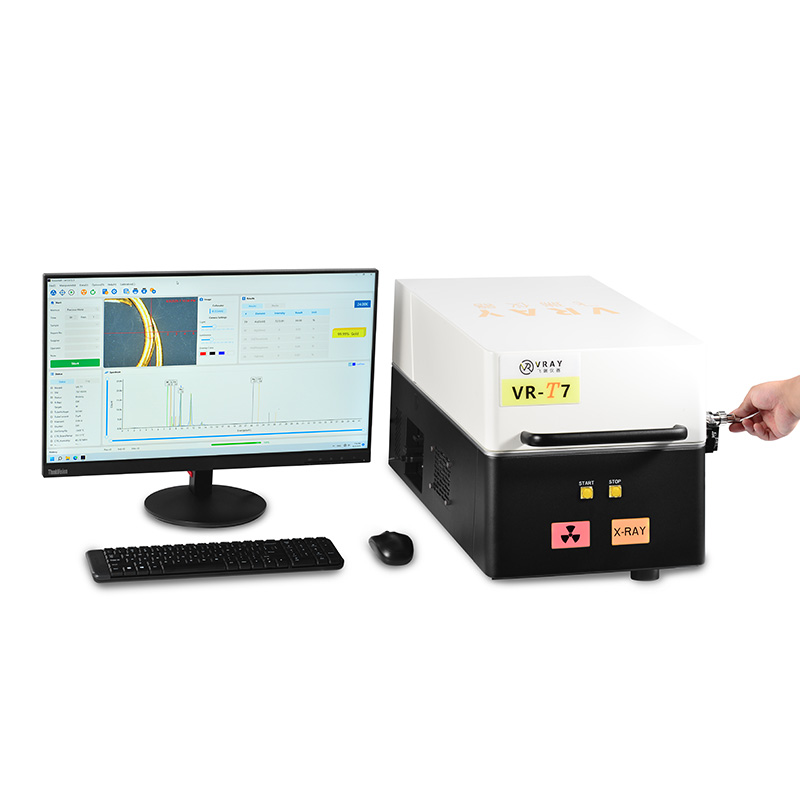Watch the video below to learn XRF Technology for Gold Tester, XRF Analyzer, Precious Metal Analyzer
XRF Technology relies on various instruments, each designed for specific applications and levels of precision. The two primary categories are Energy Dispersive X-ray Fluorescence (EDXRF) and Wavelength Dispersive X-ray Fluorescence (WDXRF), with EDXRF being more common for general-purpose, compact, and portable analyzers.
EDXRF instruments like VRAY's offerings (e.g., VR-H5, VR-M5, VR-X5, VR-S6, VR-T6, VR-T7, VR-S7) are characterized by their ability to measure the entire energy spectrum of emitted X-rays simultaneously using an energy-dispersive detector, such as a Silicon Drift Detector (SDD) or Si-Pin detector. This allows for rapid multi-element analysis. These come in various forms:
Handheld XRF Analyzers (Portable XRF or XRF Guns): These compact, battery-operated devices are designed for on-site, in-field analysis. They are lightweight and highly efficient for quick material identification and gold testing in diverse environments.
Desktop XRF Analyzers (Benchtop XRF): These are larger, more robust units designed for laboratory or workshop use, offering higher stability, often larger sample chambers, and sometimes more advanced features like integrated computers and touchscreens for detailed analysis. They can be "all-in-one" units or require an external PC.
Mini Desktop XRF Analyzers: A sub-category of desktop units that balance a smaller footprint with powerful analytical capabilities, ideal for tighter spaces without sacrificing performance.
WDXRF instruments, on the other hand, separate the X-ray signals by wavelength using diffracting crystals, offering superior spectral resolution, lower detection limits, and less spectral interference, but they are typically larger, more complex, and more expensive, primarily used in high-end laboratory settings. The choice of instrument depends on the required accuracy, portability, sample type, and budget.
XRF Technology offers numerous significant advantages that make it the preferred method for gold purity testing and precious metal analysis, far surpassing traditional methods like acid testing.
Firstly, XRF is entirely non-destructive. This is a critical benefit, especially when testing valuable items like fine jewelry, coins, or historical artifacts, as the sample remains completely intact and undamaged. Unlike acid tests which can leave marks or alter the metal, XRF ensures the integrity and value of the gold item are preserved.
Secondly, it provides instant and highly accurate results. Within seconds, an XRF gold analyzer can provide precise readings on karat value (e.g., 24K, 18K) and the full elemental composition of the alloy (e.g., percentages of gold, silver, copper, palladium, platinum). This speed and accuracy are indispensable for quick decision-making in retail, pawn shops, and refining operations, eliminating guesswork and boosting transaction confidence. High-end XRF spectrometers can even achieve accuracies like 0.01% for 9999 gold.
Thirdly, XRF offers comprehensive alloy detection and plating identification. It can identify not just gold purity but also all other alloying elements, and crucially, it can detect and differentiate between solid gold and gold-plated items, even assessing plating thickness, which acid tests cannot reliably do.
Finally, XRF gold testers are generally user-friendly and safe. Modern devices feature intuitive interfaces, reducing the need for extensive training. Unlike corrosive acid tests, XRF does not involve hazardous chemicals, making it a safer and more environmentally friendly option for operators and the workplace. This combination of speed, accuracy, non-destructiveness, and safety makes XRF technology the gold standard for precious metal analysis.

The future of XRF Technology in non-destructive metal analysis is incredibly promising, driven by advancements that will make instruments even more powerful, user-friendly, and integrated. We expect to see continued miniaturization, leading to even more compact and lighter handheld XRF analyzers with enhanced capabilities, making them suitable for an even wider range of on-site applications from mining to recycling.
Significant advancements will come from the integration of Artificial Intelligence (AI) and Machine Learning (ML). These technologies will revolutionize XRF analysis by enabling:
Universal Calibration: AI and ML can allow XRF analyzers to learn from vast datasets, enabling them to automatically adapt to different materials and applications without extensive manual calibration, drastically streamlining workflows.
Automated Calibration Selection: Instruments equipped with AI will be able to analyze spectral data in real-time, automatically identifying the material type and selecting the optimal calibration, increasing accuracy and reducing operator error.
Enhanced Data Interpretation: AI can help interpret complex spectra, detect subtle anomalies, and even predict material behavior, providing deeper insights than ever before.
Furthermore, increased connectivity options, including wireless data transfer and cloud-based data management platforms, will facilitate seamless data sharing, remote monitoring, and collaborative analysis. Improvements in detector technology (e.g., more sensitive SDDs) and X-ray tube designs will continue to push the boundaries of detection limits and analysis speed. Overall, the future of XRF points towards more intelligent, autonomous, and seamlessly integrated analytical solutions that further enhance efficiency, accuracy, and accessibility across diverse industrial and scientific applications.
What did our happy clients say?
VRAY's XRF Technology is simply top-tier! The precision of their XRF Analyzer for gold purity is consistently exceptional, ensuring reliable results every time. It's clear their commitment to cutting-edge XRF Equipment makes them an industry leader. Fantastic accuracy!
The versatility of VRAY's XRF Technology is impressive. We use their XRF Machine for everything from scrap metal sorting to identifying specific alloys. Its speed and non-destructive analysis across diverse materials have significantly boosted our operational efficiency. A truly adaptable solution!
Our VR-S7 XRF Spectrometer demonstrates VRAY's superior XRF Technology. The 0.01% accuracy it provides for precious metal analysis is phenomenal. Its advanced capabilities combined with user-friendliness make complex testing straightforward. Truly a benchmark in precision!
VRAY's handheld XRF analyzer exemplifies robust XRF Technology. Its accuracy in field conditions, from construction sites to jewelry appraisals, is consistent. This portable XRF equipment allows for reliable elemental analysis anywhere, proving its exceptional design and dependable performance.